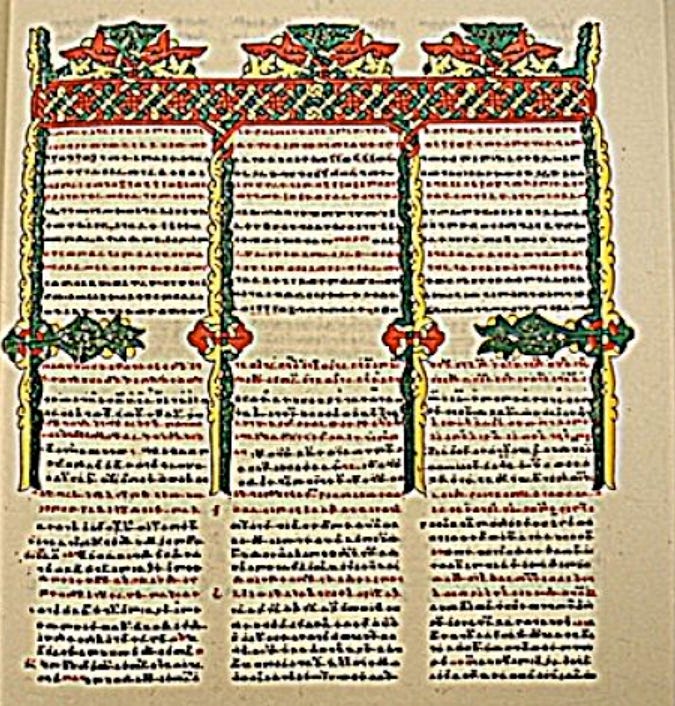Saint Yared, The Composer, Philosopher & Saint
Discover the legacy of Saint Yared, the Aksumite composer and philosopher who revolutionized liturgical music, introduced new systems of chants and various instruments, creating a long lasting legacy.
Latest Updated Version Of The Article Is On The Website

Around 535 AD1, Emperor Kaleb, one of the most renowned, if not the most renowned Aksumite emperors, passed away. Both indigenous traditions and external Greek sources recount that Emperor Kaleb abdicated his throne to become a monk in Abba Pantelewon’s church. According to some accounts, he also sent his crown to Jerusalem, dedicating it to the Holy Sepulchre as a symbol of his deep devotion to Christianity. For his remarkable piety, Kaleb is venerated as a saint in both the Ethiopian and Eritrean Churches, as well as in the Eastern Orthodox and Catholic Churches. His saintly name is Elesbaan, and he is commemorated on the 28th of May in the Ethiopian and Eritrean Churches. He is believed to have died at Abba Pantelewon’s church, and buried in the tomb nearby2.
Upon his abdication, Emperor Kaleb left three sons as rightful heirs to the Aksumite Empire: Gebre Krestos (Servant of Christ), Gebre Meskel (Servant of the Cross), and Israel3. Traditional sources offer conflicting accounts of the events that unfolded after Kaleb’s abdication, but one thing is clear—chaos ensued as the brothers vied for the throne. Israel briefly ascended to power, but Gebre Meskel soon claimed the throne and became emperor. Traditional accounts and imperial lists suggest that Israel’s reign was extremely brief, lasting less than a year, in addition to this some coins attest to his rule.
The Historian Sergew Hable Selassie tells of one particular traditional account of the events that occurred during Kaleb’s succession:
"According to some accounts, Gebre Meskal was the eldest son of Emperor Kaleb and held a significant administrative position in the southern regions of the Aksumite Empire, specifically in Shewa, until his father's abdication. His younger brother, Bete Israel, took advantage of Gebre Meskal's absence to seize the throne. When Gebre Meskal learned of this, he hurried back to Aksum, finding his brother already on the throne. Upon questioning Bete Israel, he was told that the throne was left vacant, and it was not proper for the empire to be without a king or for a woman to remain without a husband. Furious, Gebre Meskal initially intended to wage war against his brother to reclaim the throne by force.However, the priests intervened, bringing the Ark of St. Michael and the Chariot of the Ark of the Covenant (tabot).
They urged Gebre Meskal to wait while they sought Emperor Kaleb's guidance on who should rightfully succeed him. Gebre Meskal agreed and sent the priests to his father, who was now a monk. Kaleb, refusing to leave his cell or see anyone, declared that Gebre Meskal was to be his successor and cursed Bete Israel for his usurpation.Upon receiving this pronouncement, Bete Israel either immediately died, as some traditions suggest, or fled into hiding with the Ark of St. Michael, becoming the leader of the Zar cult. The internal strife weakened the Aksumite Empire, leading to the loss of South Arabian territories as they fell under Persian control. ." - Ancient And Medieval Ethiopian History to 1270, pg 160
If this traditional account is to be believed, it means Aksumite control southwards, had reached Shewa by at least mid-6th century AD.
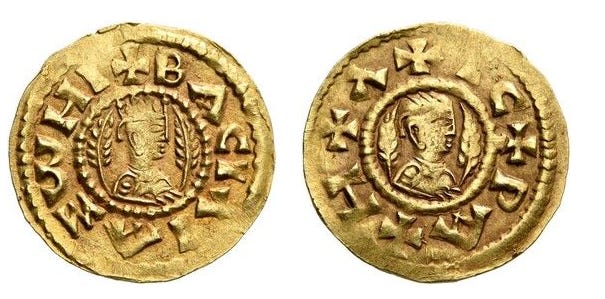
Emperor Gebre Meskel (~535AD-548AD)
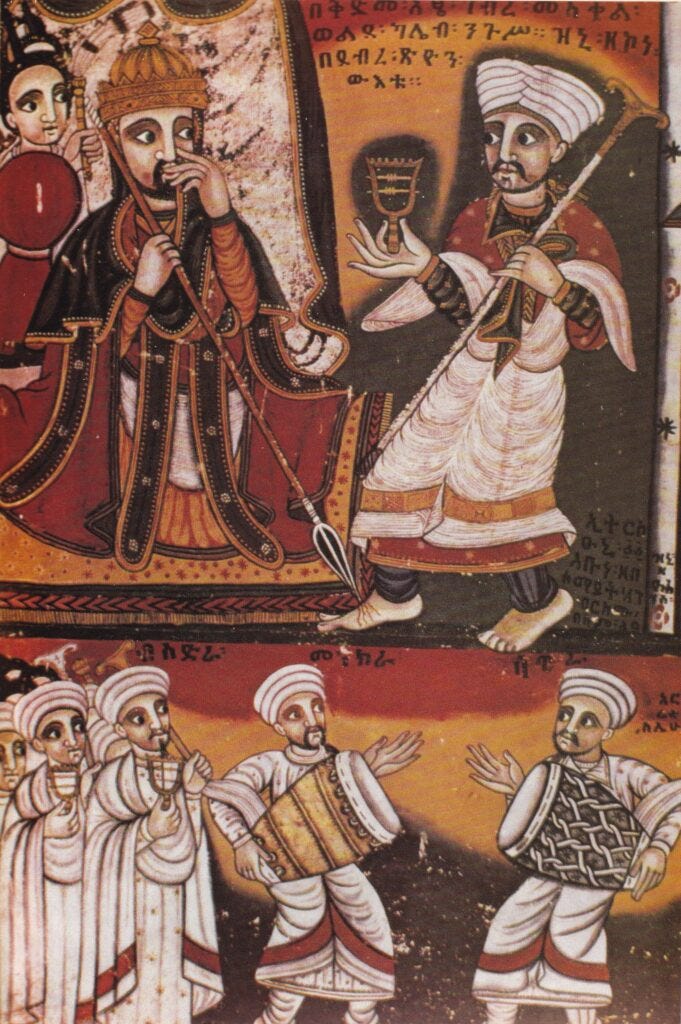
After the brief reign of Emperor Israel, the throne passed to Gebre Meskel. Unlike his father Emperor Kaleb, Gebre Meskel is not renowned for grand conquests or quelling rebellions. Instead, his legacy is marked by the significant advancements in the liturgy, culture, and architecture of the empire during his reign. Numerous churches were commissioned and constructed under his patronage, including those for the Nine Saints, such as Abba Afse church in Yeha, Debre Damo and Zuramba in Gayant, South Gondar4. One traditional story goes that Zauramba was built because Abba Aregwi had a vision where he was ordered by heavenly bodies, to build a second church on a mountain like that of Debre Damo5. Saint Yared would go on to spend over a decade teaching at this church.
The name 'Zuramba' is derived from the words 'zur' (to go around) and 'amba' (mountain). Tradition states that a saint advised Abba Aragawi to go around the mountain, to find the location to build the new church6.
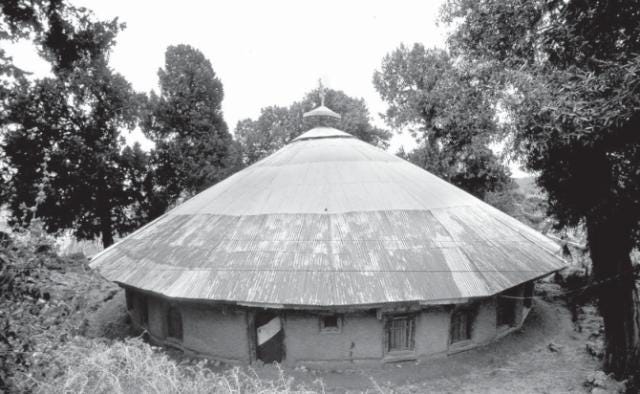
According to traditional sources, Gebre Meskel is believed to have travelled to Jerusalem and built a church in Nablus, a city in the modern-day West Bank. However, Arabic sources claim that it was Antioch in Syria where he attempted to build the church, though this mission ultimately failed when the ship carrying the materials sank near Jeddah7. When messengers asked what should be done, Gebre Meskel allegedly responded that the remaining wood could be used to rebuild the Ka'aba. The authenticity of this account, however, remains questionable. The story goes as follows:
"The Negasi, the King of Abyssinia, desired to build a church that would bear his name at Antioch in Syria. For this purpose, he sent a man to make an estimate of the necessary outlay and of the quantity of wood needed. He collected all the wood, of all dimensions, both large and small, already cut and prepared to be used for construction. He had it loaded on a big ship and then added a further supply of wood and also put aboard the ship skilled carpenters and an overseer, providing them with the money needed for their expenses. He then sent them to Syria to construct the church. There was abundant wood in Syria, but the King of Abyssinia wanted to use his own wood, in accordance with one of those whims usual in a king. While the vessel was passing close to Jeddah it sank; but the wood floated on the sea.
The people from the vessel clung to the wood and the wind carried them to Jeddah where they landed. They collected and brought ashore all the wood which was floating on the surface of the sea. Then the overseer and others discussed what they should do next. Some said, 'We are carpenters, we have sufficient wood here to build another vessel and to take the rest to Syria'. Others said, '[Such a small quantity] would not be worthy of the king; let us hire another vessel on which to travel.'
The overseer said: 'I do not dare to do anything without the King's authorization. I shall write to him and we shall wait for his orders here. When the inhabitants of Mecca heard this news, Abu-Talib and the elders of the city came to Jeddah and asked the overseer to sell them the wood at whatever price he wished. They said to him: 'Sell us this wood and lend us the services of these carpenters at the salary you choose, for we are re-building the temple of the Ka'aba; that temple which was erected to God by Abraham.' The overseer replied: 'Wait until I ask for the orders of the king.'
He hired a vessel and sent a messenger with a letter to the king in which he described what had happened to him and the ship-wreck, and asked him whether he should return or go on to Syria. At the end of the letter, he mentioned the proposal made by the people of Mecca. The Negus wrote to the overseer: 'I donate all the wood to the temple of the Ka'aba. Go to Mecca with the carpenters and let them build the temple. Spend the money which you have with you for the construction.' The overseer did as he was told and then returned." - Ancient and medieval Ethiopian history to 1270, pg 163 & 164
Gebre Meskel would reign for nearly 14 years, and thus pass away around 548AD8.
Saint Yared
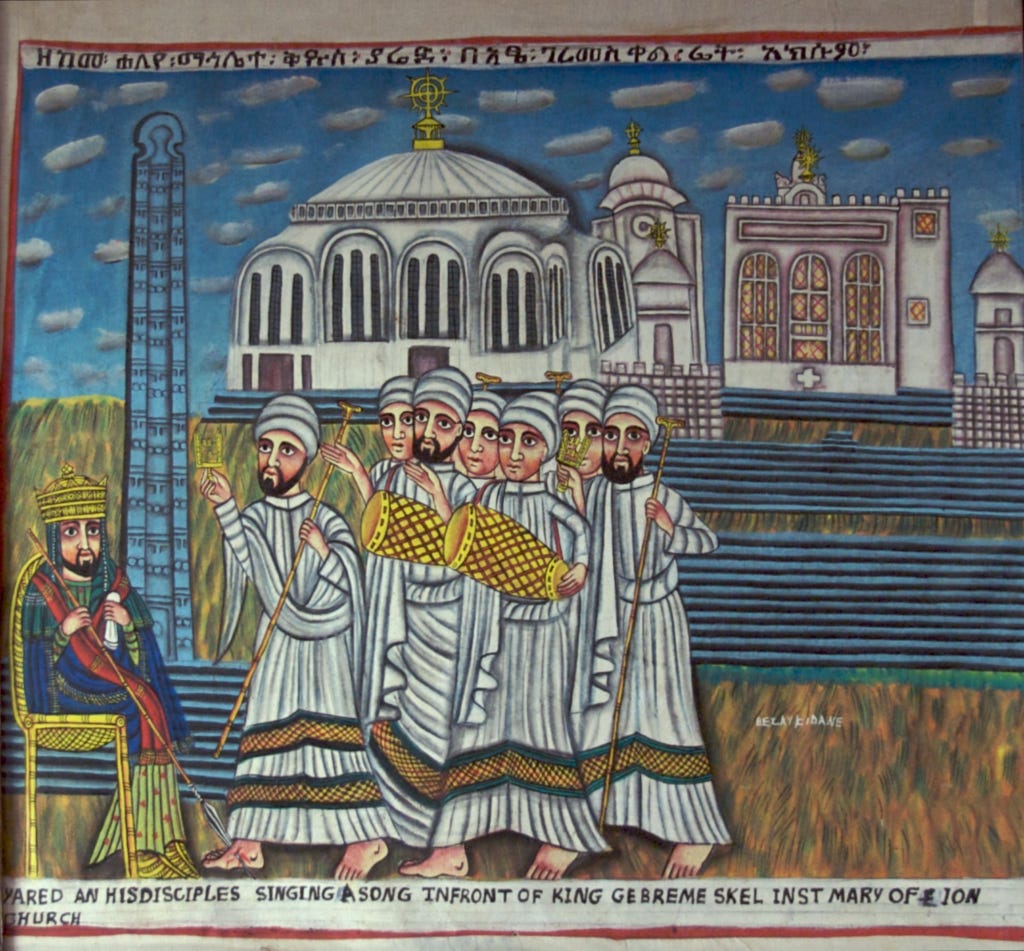
The most celebrated event during Gebre Meskel's reign was the flourishing of Habesha liturgical music, spearheaded by the renowned composer Saint Yared. According to tradition, Saint Yared was born in Aksum in 513 AD (505 AD in the Ge'ez calendar)9. His father, Isaac (also known as Aybud or Adam), and his mother, Christina (also known as Tawklia), hailed from a wealthy Aksumite family with strong ties to the church10. In his early years, Yared was tutored by Yishaq, a teacher in Aksum, where he learned the Ge'ez alphabet and began studying the Psalms11.
After the death of his father when Yared was around seven years old, his mother entrusted his upbringing to his uncle Gedewon, a priest and biblical scholar who became a father figure to him12. Yared continued his studies at the Church of St. Mary of Zion in Aksum, where he struggled initially to memorize the Psalms. Known for being an impatient learner, his constant failure led to punishments by Gedewon13. Disheartened, Yared decided to flee back to his mother. However, while resting under a tree on his journey, he observed a caterpillar (or, in some accounts, an ant/grasshopper) repeatedly attempting to climb the tree. Despite falling six times, the creature persevered and finally reached the fruit on the seventh attempt14.
Inspired by the persistence of the small creature, Yared learned a valuable lesson about hard work and perseverance, thus he returned to his uncle with renewed determination. He dedicated himself to his studies, ultimately mastering the Psalter and memorizing both the Old and New Testaments15. Yared went on to become a deacon at the Church of Our Lady Mary Zion in Aksum and later a priest, and he taught for sixteen years16.
Liturgical works
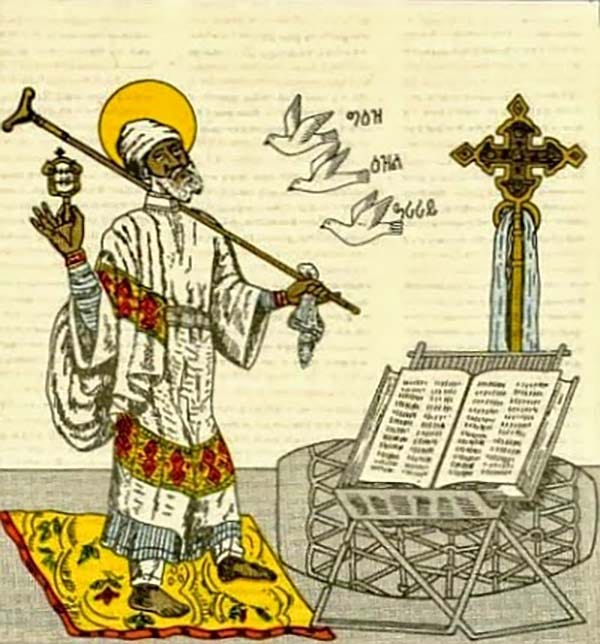
Saint Yared revolutionized the liturgical music of the Aksumite Church by introducing vibrant new elements, including vocal singing and the use of instruments. Before his influence, liturgical chanting was performed softly, almost in a murmur, but Yared transformed it into louder & more powerful hymns. According to tradition, Yared claimed to have visited Constantinople twice17, where he likely observed and absorbed elements of Byzantine liturgical music. His close connection with the Nine Saints, who had extensive experience throughout the Mediterranean, also likely influenced his musical compositions.
Tradition states to the contrary, rather it was through divine revelation that Yared introduced these techniques. Specifically, it states that God sent three angels to reveal three heavenly chants, these angels came in the form of three birds, these birds sang these three chants to him and praised Yared, they then carried him to heaven where the trinity imparted the knowledge of heavenly songs in him, he also saw the angels playing musical tunes using instruments such as the Kebero (Drum), Begena (harp), Tsenatsil (sistrum - rattling instrument), Masenquo (violin), Washint (flute) and the Mequamia, which is a stick used for tapping sounds & as support during long church services18. He then was returned back to Aksum. Imparting this knowledge to his clergy by introducing these instruments into his hymns, in addition to creating musical signs & symbols.
Instruments
Chants
Specifically, the three modes of chants that he introduced were19:
Books & Later Life
Saint Yared also wrote five liturgical books, each containing several hymns to be sung at specific times throughout the year, these books are as follows20:
Digua (also spelled as Diggua), is his most cited work, Digua means lamentation in Tigrinya. This book contained a collection of hymns in the form of poems that cited not only biblical passages but also Yared personal opinions and philosophies regarding biblical characters, events and situations, in addition to historical summaries of the nine saints. For example, he says the following:
Saint Yared also introduced Qine, which is where a prospective liturgical student is tasked with creating a poem following strict rules (such as the number of verses allowed), thereby teaching Ge'ez vocabulary, grammar and syntax21.
Saint Yared also created 10 different forms of notation to be using in liturgical hymns:
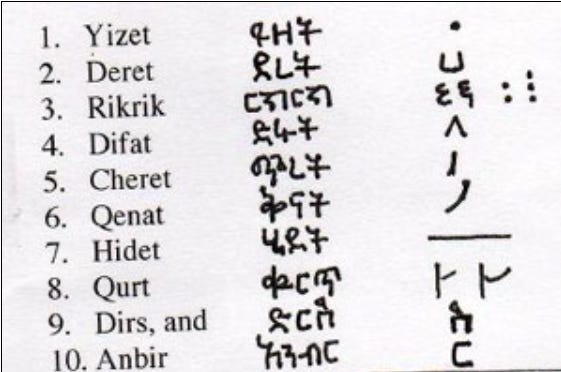
Saint Yared's musical genius earned him a close relationship with the imperial court, where he captivated the monarchy with his performances22. It is traditionally believed that during the reign of Gebre Meskel, the festival of Hosanna (Palm Sunday) was introduced. This festival commemorates Jesus' triumphant entry into Jerusalem, where he was greeted with palm leaves by the local inhabitants as he rode a donkey. Additionally, Yared is credited with establishing a religious ceremony to be held before the coronation of new emperors, further intertwining music and royal tradition.
In one Interesting traditional tale, Yared is performing for Emperor Gebre Meskel, and while both were fully captivated by the music, the Emperor accidentally moved his spear (Spears were part of the Aksumite royal regalia - both coins minted by Aksumites and foreign ambassadors such as the roman ambassador Nonnosus describe this) thereby piercing Yareds foot, however because both were so enthralled by the music, none noticed until Yared finished his song. When the Emperor noticed, he apologized to Yared & offered him a reward for the trouble he had caused. Yared asked to be in peace, living as a monk alone in the Simien mountains. Thus even though much of the royal court and the people of the empire were saddened by this, Yared was allowed to depart, or else the Emperor would be an oathbreaker. Yared never came back and died on the 19th of May (11 Ginbot) in 571AD, which is the same day his celebrated in both the Ethiopian & Eritrean Orthodox Churches23.
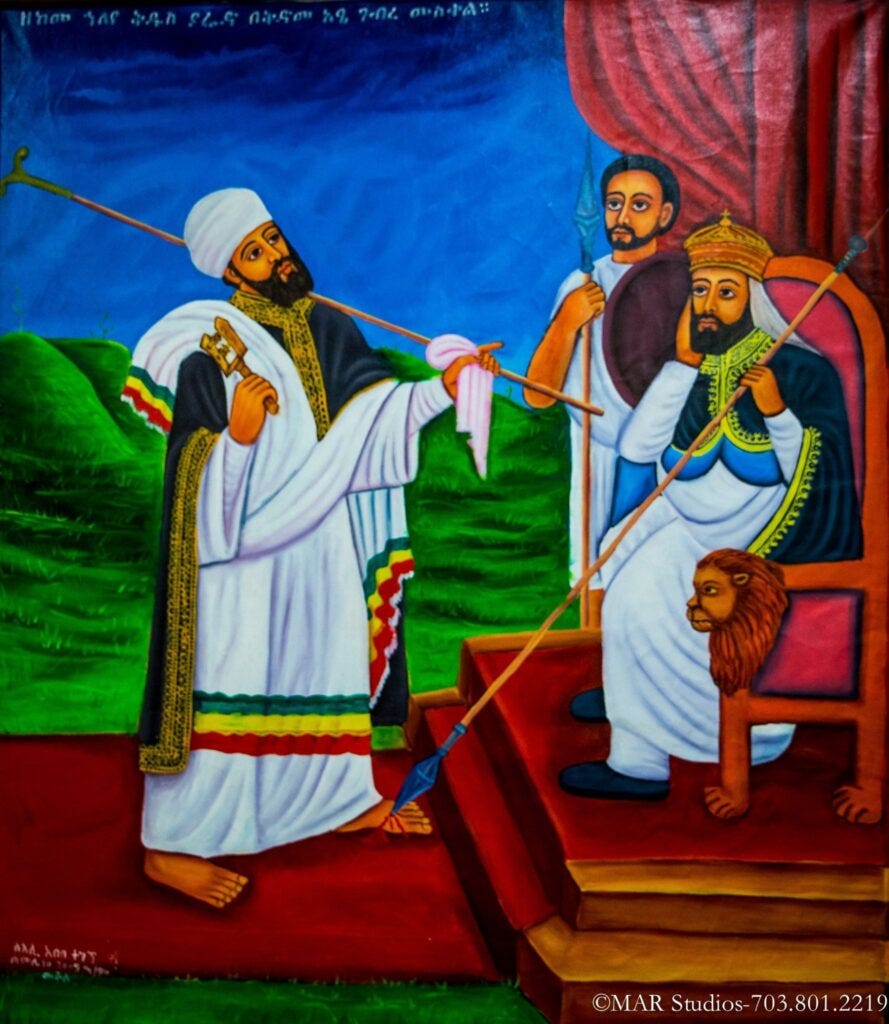
The following describes the life of Saint Yared according to the traditional text "The Book Of The Saints Of The Ethiopian Church":
"And on this day also died Yared, the poet and hymn writer, who was like unto the Seraphim. This man was a kinsman of Abba Gideon a priest of ‘Aksum, which city held the first church that was built in the country of Ethiopia, and in [this church] was first preached the Faith of our Lord Christ, and it was consecrated (i.e. dedicated) in the name of our holy Lady, the Virgin Mary, the God-bearer. When this Abba Gideon began to teach the blessed Yared the Psalms of David, he was unable to keep him with him for many days at a time, and then when he beat him, and made him to suffer pain, he fled into the desert and took up his abode under a tree. And he saw a worm (caterpillar ?) which was climbing up the tree, and when it had climbed up half way it fell down upon the ground; and this it did many times, because of the difficulty of climbing the tree. And when Saint Yared saw the perseverance (?) of the worm, he repented in his soul and returned to his teacher and said unto him, “Forgive me, O father, and dispose of me as thou wishest.”
And his teacher, a spiritual man, received him, and having asked God with tears He opened the thoughts of Yared’s understanding, and he learned in one day the Books of the Old and the New Testaments; and then he was made a deacon. Now in those days there was no singing of hymns and spiritual songs in a loud voice to well-defined tunes, but men murmured them in a low voice. And God, wishing to raise up to Himself a memorial, sent unto him three birds from the Garden of ‘Edom, and they held converse with Yard in the speech of man, and they caught him up, and took him to the heavenly Jerusalem, and there he learned the songs of the Four and Twenty Priests of heaven. And when he returned to himself, he went into the First Church in ‘Aksum, at the third hour of the day, and he cried out with a loud voice, saying, “Hallelujah to the Father, Hallelujah to the Son, Hallelujah to the Holy Spirit.” The first Hallelujah he made the foundation, and called it “Zion.”
In the second Hallelujah he showed forth how Moses carried out the work of the Tabernacle, and this he called a “Song of the heights.” And when they heard the sound of his voice, the king, and the queen, and the bishop, and the priests, and the king’s nobles, ran to the church, and they spent the day in listening to him. And he arranged hymns for each season of the year, for summer and winter, and spring and autumn, and for festivals and Sabbaths, and for the days of the Angels, the Prophets, the Martyrs and the Righteous, in three modes, that is to say, the first mode to be used on ordinary days, the second mode to be used on fast days and days of mourning, and the third mode to be used on the great festivals. And there were not lacking (?) in these three modes any of the sounds that are made by men, and birds, and beasts.
One day whilst Saint Yared was singing by the footstool of King Gebre Meskel, the king (died A.D. 1344) was so deeply absorbed [in listening to] his voice, that he drove his spear into the flat part of Yared’s foot with such force that much blood spurted out; but Saint Yared did not know of it until he had finished his song. And when the king saw this he was dismayed, and he drew his spear out of his foot, and said unto him, “Ask me what ever reward thou wishest for in return for this thy blood which hath been shed”; and Saint Yared said unto him, “Swear to me that thou wilt not refuse me.”
And when the king had sworn Saint Yared said unto him, “Send me away that I may become a monk.” When the king heard this he was exceedingly sad, and his nobles likewise, but he was afraid to prevent him because of his oath. And when Saint Yared had gone into the church, he stood before the Tabernacle of Zion, and when he had said the prayer from the beginning, “Holy, and honorable, and glorious, and blessed, and praised, and exalted” to the end thereof, he was raised above the ground the space of a cubit. Then he departed to the desert of the south, and he lived there in fasting and prayer; and he mortified his flesh exceedingly, and finished his strife there. And God gave him the promise concerning the man who should invoke his name or celebrate his commemoration; and he died in peace and the place of his grave in the south is not known to this day. Salutation to Yared." - The book of the saints of the Ethiopian church, Ginbot 11
A page containing a chant, in the Book Of Digua. (Source)
Check out the forum page about this article for links to books & websites used & for further reading
The following YouTube video not only briefly explains Saint Yarid's life but also includes numerous performances of his chants :
Bibliography
Ancient And Medieval Ethiopian History to 1270, pg 143
Ancient And Medieval Ethiopian History to 1270, pg 143
Ancient And Medieval Ethiopian History to 1270, pg 159
Ancient And Medieval Ethiopian History to 1270, pg 162
https://en.sewasew.com/p/zuramba-(%E1%8B%99%E1%88%AB%E1%88%9D%E1%89%A3)
https://en.sewasew.com/p/zuramba-(%E1%8B%99%E1%88%AB%E1%88%9D%E1%89%A3)
Ancient And Medieval Ethiopian History to 1270, pg 163
Ancient And Medieval Ethiopian History to 1270, pg 166
https://www.abbayesehaq.com/htm/yared.htm
https://www.styaredcuisine.com/about.html
https://www.styaredcuisine.com/about.html
Ancient And Medieval Ethiopian History to 1270, pg 165
https://www.styaredcuisine.com/about.html
Ancient And Medieval Ethiopian History to 1270, pg 165
Ancient And Medieval Ethiopian History to 1270, pg 165
https://www.styaredcuisine.com/about.html
https://ethiopiangospelmusic.net/solo/yared-melodious/
http://www.tadias.com/11/29/2007/st-yared-the-great-ethiopian-composer/
Ancient And Medieval Ethiopian History to 1270, pg 168
Ancient And Medieval Ethiopian History to 1270, pg 166
Ancient And Medieval Ethiopian History to 1270, pg 166





